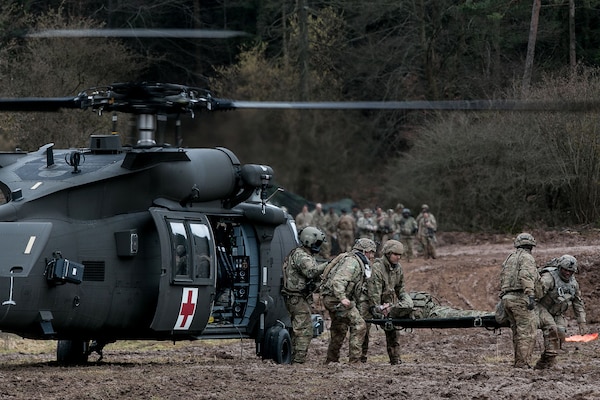By Army Spc. Dustin D. Biven, 22nd Mobile Public Affairs
Detachment
JOINT MULTINATIONAL READINESS CENTER, Hohenfels, Germany,
Jan. 31, 2018 —When people are ill or injured, they typically go to their local
doctor for care or treatment. However, when soldiers are ill or injured in a
combat environment, they depend on the healing hands of their combat medics.
In the hills surrounding this 40,000 acre training area,
soldiers faced an environment that simulated what combat could be like during
the ongoing Allied Spirit VIII training exercise.
About 4,100 participants from 10 nations are taking part in
the exercise, which runs Jan. 15-Feb. 5. Nearly 2,420 participants will come
from the United States and approximately 1,680 participants were expected to
participate from allied and partner nations of Albania, Canada, Czech Republic,
Denmark, Italy, Lithuania, Poland, Romania and the United Kingdom.
In this exercise, Poland's 12th Mechanized Brigade will
command the multinational brigade headquarters. The Allied Spirit series
rotates countries as the brigade headquarters leading the exercise, so all
participating countries gain experience in working together in and for a
multinational effort.
Allied Spirit VIII is unique in its ability to provide
hands-on experience and testing of secure communications between NATO allies
and partners.
Soldiers must remain vigilant in this exercise at all times
as opposing forces scattered around the area periodically attack with small
arms, tracked vehicles and aerial support.
“We can't choose where the next combat zone will be, we just
have to be prepared for anything,” said Army 1st Sgt. Joe Best, a combat medic
with the 557th Medical Company. “We had [simulated] injured personnel brought
in yesterday by aerial support, and without hesitation our medics responded and
successfully transferred the injured from the UH-60 Black Hawk to a field
litter ambulance stationed nearby.”
Medics were evaluated on how effective and quickly they
could receive, transport and treat injured personnel brought in by air support
in a combat environment.
Difficult Conditions
Though the terrain where the medical station is located is
covered in deep mud, soldiers quickly adapted to their environment and overcame
the difficulties.
“The recent snow has melted and caused the location we're at
to become less than ideal,” said Army Sgt. Noah Hughes, a combat medic with
557th Medical Company. “But when lives are on the line, there is no room for
excuses, we adapt and overcome. We positioned our [ambulance] near … the UH-60
Black Hawk and our litter team was quick to receive the information on the
patients from the flight medic and get them to the next level of care.”
Soldiers who are injured in the field or in a combat
environment can't depend on having a fully operational medical facility nearby.
Sometimes, the closest lifesaving treatment can be found in a pop-up tent.
“It's training events like Allied Spirit that helps save
lives in combat,” Hughes said. “I live by the saying, 'More sweat in training
means less blood in combat,' meaning the harder we train the more effective
we'll be when in combat.”
For serious injuries, a field setup would not be the last
stop in a soldier’s line of care, it's usually the half-way point.
The initial care given to an injured soldier in a combat
zone is called first aid. This includes lifesaving measures to stop and control
any bleeding and to make sure the injured soldier is breathing well.
Once the patient is medically evacuated to a field medical
facility, more in-depth treatment can be conducted. At this stage, further
steps are taken to care for and treat the patient’s wounds.
“No matter what environment we are faced with, my medics are
trained and ready.” Best said. “The U.S. and its allies are an effective force,
deterring aggression and sustaining the front lines of combat.”

No comments:
Post a Comment